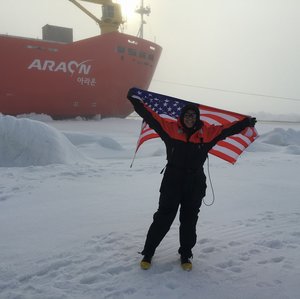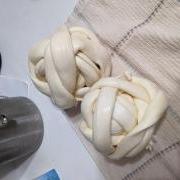The Next Wave — our student researchers
Blanca Rodriguez
Blanca Rodriquez is an excellent example of someone who followed her interests to a doctorate degree in a field she is passionate about—Earth System Science. She is on the verge of fulfilling this dream, as she defended in late January and is busy finishing up her remaining projects and publications.
 Blanca’s academic trajectory has led her from Chemistry to Earth System Science, and from the desert to the Arctic. During her junior and senior years at Arizona State University, Blanca joined a research group that was measuring trace metals and organic toxins in haboobs in the Phoenix metro area. This was her first exposure to environmental academic research and, during her last year at ASU, she enrolled in advanced classes that highlighted the interdependence between geological, biological, and atmospheric systems. These courses inspired her to further her understanding of the interactions between these systems so, after receiving her B.S. in Chemistry from ASU, she applied and was accepted to UCI's Earth System Science doctoral program in 2015.
Blanca’s academic trajectory has led her from Chemistry to Earth System Science, and from the desert to the Arctic. During her junior and senior years at Arizona State University, Blanca joined a research group that was measuring trace metals and organic toxins in haboobs in the Phoenix metro area. This was her first exposure to environmental academic research and, during her last year at ASU, she enrolled in advanced classes that highlighted the interdependence between geological, biological, and atmospheric systems. These courses inspired her to further her understanding of the interactions between these systems so, after receiving her B.S. in Chemistry from ASU, she applied and was accepted to UCI's Earth System Science doctoral program in 2015.
Her work in the haboob project (which incidentally involved switching out filters at the top of a university building on 115-degree Fahrenheit days!) piqued Blanca’s curiosity about atmospheric aerosols and the lifecycle of atmospheric particles. During her first two years in Professor Claudia Czimczik’s research group, Blanca became fascinated with the versatility of radiocarbon analysis of particulate matter. At the same time, some of the Czimczik group’s collaborators became interested in using radiocarbon analysis to study source apportionment of fossil fuel “black carbon” (black particles containing soot) in the high Arctic.
In working with the collaborators, Blanca’s research interests expanded again through trying to understand how the Arctic atmosphere, generally a low-pollution region of the world, can become so polluted during the winter/spring time (the phenomenon known as “Arctic haze”) and utilizing carbon isotopes to determine what the sources might be.
With the help of their collaborators, the Czimczik group has been able to develop a new method for collecting and processing tiny amounts (<100µg C) of particulate matter for radiocarbon analysis. Blanca used this novel approach to determine the temporal and spatial contributions of fossil fuel combustion to black carbon in aerosol and snow, something that could not be done previously because of the very small amounts of black carbon in the snow at Alert, Nunavut, Canada. In addition, she used both stable and radiocarbon analysis to assess the importance of dissolved organic carbon from the oceans to marine aerosol. Dissolved organic carbon is a huge carbon pool in the ocean that is formed as a byproduct of life in the ocean. It is highly complex in a chemical sense and its formation/removal mechanisms have yet to be resolved. Additionally, Arctic rivers—accelerated by permafrost thaw and glacier melt—may be helping to move ancient dissolved organic carbon from land to the ocean.
aerosol. Dissolved organic carbon is a huge carbon pool in the ocean that is formed as a byproduct of life in the ocean. It is highly complex in a chemical sense and its formation/removal mechanisms have yet to be resolved. Additionally, Arctic rivers—accelerated by permafrost thaw and glacier melt—may be helping to move ancient dissolved organic carbon from land to the ocean.
Blanca feels she had the opportunity of a lifetime when she was invited to conduct sample collection on a research vessel icebreaker aboard the ARAON (Korean Polar Research Institute). They sailed from Incheon, South Korea to Nome, Alaska and further northward to the Chukchi Sea, and finally to Utqiaġvik, Alaska in the summers of 2016 and 2017. As other researchers can attest, while these trips can be a lot of fun it was also stressful to troubleshoot issues in the field. Within just a one-year time difference, Blanca was able to witness the variability of sea ice conditions. It was disappointing that she didn't have a chance to see a polar bear, but did see their footprints along with Arctic seals.
Blanca has been an author on four publications with two more on the way. She also presented her work highlighting the new method of radiocarbon analysis at the Radiocarbon in the Environment event in Debrecen, Hungary in 2017. In addition, she gave an oral presentation at the American Geophysical Union Fall Meeting of 2018 on the ARAON work, and she gave a poster presentation for the AGU Fall Meeting in 2020 highlighting the work at Alert, Canada.
Professionally, Blanca is eager to apply her research skills through working in the public or industry sectors for environmental regulation and enforcement. She looks forward to using her considerable expertise to find solutions to environmental issues and to protect both human and ecosystem health. Blanca is now enthusiastically seeking her next adventure in this direction and exploring her various options for life after UCI.
Outside of the lab, Blanca enjoys bike rides through the beautiful wetlands and bays of the Orange County coast. Also, in the interest of transitioning to an eco-friendly and self-sufficient household and kitchen, she has become interested in fermentation of many culinary flavors. Nowadays she’s into cheese making, and so far has conquered cream cheese, mozzarella, paneer, and “quesillo” or Oaxaca, shown in the adjacent photo. We can only guess at the many more exciting projects to come from Dr. Blanca Rodriguez in the lab or in the kitchen!

